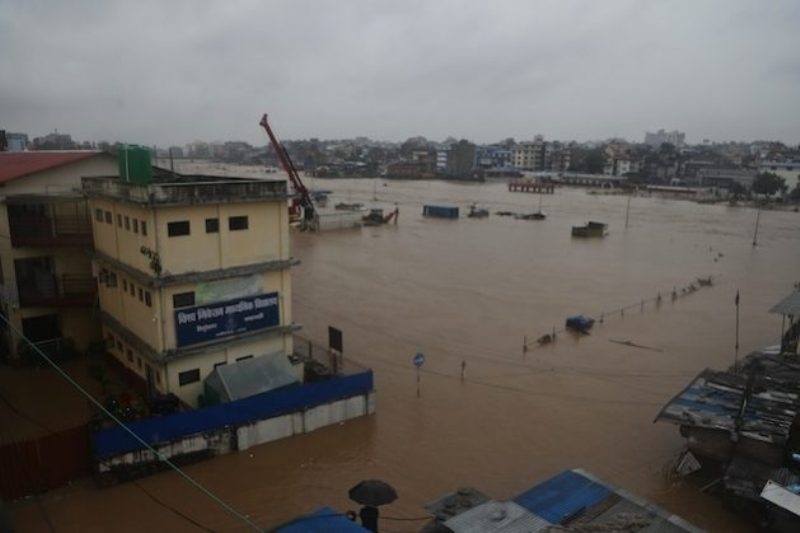- CEC Vows Credible Election to End Stigma |
- High-level meeting reviews country’s economic progress |
- Dhaka suspends visa, consular services at its Delhi, Agartala Missions |
- Govt to cut savings certificate profit rates from January |
- Gold prices hit fresh record in Bangladesh within 24 hours |
Nepal’s Deadly Flash Floods: What Went Wrong?

Kathmandu under water because of heavy rainfall, which claimed more than 225 lives in last week of September. Photo- Barsha Shah-IPS
By Tanka Dhakal
KATHMANDU, Oct 3 2024 (IPS) - Nepal is trying to recover from recent flash floods and landslides caused by heavy rainfall over the last weekend of September, which claimed at least 226 lives. The mid- and eastern parts of the country, including the capital, Kathmandu, experienced the heaviest monsoon rains in two decades from September 26-28, leaving many parts of Kathmandu underwater. Experts say this is one of the deadliest and worst flash floods that impacted thousands of people in decades.
The National Disaster Risk Reduction and Management Authority (NDRRMA)—facing intense backlash for its inability to act effectively to minimize losses—reported by Tuesday (October 1) that at least 25 people were still stranded or missing, while more than 150 were injured.
On September 28, the country’s 25 weather stations in 14 districts recorded new precipitation records within 24-hours. Kathmandu airport stations recorded 239.7 millimeters of rain. Before that, on July 23, 2002, it had recorded 177 mm of rainfall. Flash floods caused by extreme rainfall within a short period washed away entire neighborhoods, roads, and bridges in Kathmandu and surrounding areas.
The heavy rains caused rivers in Kathmandu, including the Bagmati, which runs through the city, to swell more than 2 meters above the safe level. Senior journalist Yubaraj Ghimire—whose house was also submerged—wrote, “The disastrous hours of terror further confirmed the state’s incompetence in times of need.”
Early warnings were there, but lives were lost!
Frustration is growing, not only because of its failure in conducting effective rescue operations but also for not acting on the information that was available beforehand about the forthcoming disaster.
The Department of Hydrology and Meteorology (DHM) issued a special weather bulletin at least five days prior, alerting the public to impending heavy rainfall that could result in flooding and landslides.
In the bulletin, the DHM labeled districts with red, orange, yellow, and green, urging “Take Action,” “Be Prepared,” “Be Updated,” and “No Warning,” respectively.
Again, on September 25, the DHM issued another “special weather bulletin,” this time labeling most parts of the country in red, or the “Take Action” category.
As predicted, heavy rain started pouring—rivers began flowing with water levels higher than the safe limit.
“The information was there, but it doesn’t seem like it was taken seriously to be prepared,” Dr. Ngamindra Dahal, who works on climate change-induced disaster risk reduction, said. “To minimize consequences, we need to take action according to the information we have, but that was not the case in most parts.”
Prime Minister K.P. Sharma Oli acknowledged that the government was not prepared for a disaster of this scale. In a press conference on Tuesday, Oli said, “Our preparedness was not for this kind of circumstance. We were not expecting this scale of rains, landslides, and human and infrastructure losses.”
But the weather agency, DHM, had been warning and urging appropriate action through multiple notices. Government agencies admit they were not able to communicate disaster-related information effectively.
Why was NDRRMA not able to act quickly?
This time, the weather information was accurate in most parts, but avoidable incidents still claimed lives.
“I was traveling, and what I can say is that even though there was information beforehand, it was not transformed into action,” Dahal added. “I do think NDRRMA and other stakeholders could have done better to reduce casualties.”
But the agency responsible for disaster risk reduction and management—NDRRMA—claims that it was due to their collaborative effort with other stakeholders that human casualties were lower.
“That information did help, and it is because of us that things are not worse than this,” Dr. Dijan Bhattrai, spokesperson for NDRRMA, said.
“In the case of Kathmandu, our urban setting is not capable of handling this kind of disaster, and in other parts of the country, it was a combination of intense rain and fragmented geological conditions due to the 2015 earthquake.”
Stakeholders have publicly acknowledged the role of river encroachment and unplanned settlement in Kathmandu, and this problem is well-known. However, for this recent disaster, people are angry because they noticed a clear gap between the information and the preparedness effort.
“It’s true we were not well-equipped to deal with this kind of situation in terms of resources and trained manpower,” Bhattrai claimed. “We did our part, doing what we could within our capacity.”
Is it exacerbated by climate change?
In recent years, scientists have said that climate change is altering the amount and timing of rainfall across Asia. However, the impact of floods has increased due to the built environment, including unplanned construction, especially on floodplains, which leaves insufficient areas for water retention and drainage.
A recent report published in Nature Communications states that Asia’s exposure to extreme rain and flood risk will grow by 2030.
“Definitely, there is much to do in terms of effective disaster communication and actionable preparedness, but it is also a fact that these kinds of events are becoming more frequent because of climate change,” Bhattrai said. “We are planning to lay our case at the upcoming UN climate conference (COP29) to secure more resources to deal with future disasters.”
IPS UN Bureau Report

